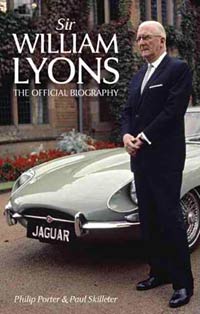|
There is no shortage of books on the market concerning themselves with Jaguar cars, whether they be sportscar icons such as the E-Type or XK in its various forms, or their swift and seductive saloon cars such as the XJ6 of 1968. Having owned some early XJs myself, and having a father who has also dabbled with Jaguars on and off over the years (he now owns an X350 XJ6), any book on the subject of Jaguar and the people involved, will likely as not find a welcome home on my own bookshelves.
|
|
This official biography by well-known Jaguar historians Philip Porter and Paul Skilleter first appeared in hardback form in 2001, on the centenary of Sir William's birth, and was reprinted ten years later in paperback form in August 2011.
|
|
The reader is taken back to Lyons' formative years, and his introduction to motorised transport courtesy of a 1911 Triumph motorcycle and, in 1917, his enrolment as an apprentice for Crossley Motors Ltd in Manchester. These experiences provided Lyons with a grounding in the booming motor-car industry, at a time when adoption of motorised vehicles, in preference to the horse-drawn variety, was in full swing and the roads were beginning to host these strange mechanised forms of transport in appreciable numbers. This knowledge led to the formation of the Swallow Sidecar Company in 1922, a co-operation between William Lyons and William Walmsley.
|
|
Success with the sidecars led to the production of coachbuilt bodywork for cars such as the Austin 7, a project that by the end of 1926 was gathering pace aplenty. The story of Lyons' involvement with vehicle production up until the outbreak of WW2, and in the years following VE day, are well documented in this book, aided by personal anecdotes both from people who worked with him, and members of his own family. Black and white photographs add to the story in their own way, from the production of motor-cars under the SS and later Jaguar maker's name, to the company's legendary successes in sportscar racing in the 1950s with the C-Types and D-Types.
|
|
Naturally not everything in life always goes to plan, and the devastating factory fire of 1957 could easily have led to the company folding. However this was not to be, and local suppliers dug in with the indomitable Lyons and his workforce in a bid to restore a level of production back to the site. Six days after the fire, limited production had resumed.
|
|
The introduction of the classic 2.4/3.4 saloons, followed by the Mk2 and the S-Type, ran alongside production of the sporting road cars throughout the remainder of the 1950s and into the 1960s, all by this time powered by the legendary XK six-cylinder engine. Jaguar was not a company to rest on its laurels, and investigations into new engines, and engine configurations, continued throughout the sixties, with different versions of the V12 concept undergoing extensive testing prior to the engine's launch under the bonnet of the Series 3 E-Type, in the early 1970s, by which time the firm had merged into the BLMC combine, with Lyons remaining as Chairman of the Jaguar arm.
|
|
By the late '60s Jaguar was producing too many disparate models, in uneconomically-low volumes, so the introduction of the XJ6 in 1968 simplified their range enormously and re-wrote the rule book note only in terms of styling for a four-door luxury saloon, but also refinement, roadholding and ride comfort. The Series 1s XJ6s (2.8 and 4.2 litre) were joined by the SOHC-per-bank 5.3 litre XJ12 in 1972, further raising the bar in terms of overall performance, if not fuel economy. Throughout the decade, under Lyons' watchful eye, the range would evolve into the Series 2 and, incorporating design cues brought in by Pininfarina, the Series 3, which served Jaguar well into the 1990s until such time as a twelve-cylinder version of the XJ40 series, launched initially in six-cylinder guise only, was ready for production.
|
|
While most of the cars produced under the Lyons era were warmly received at launch, this wasn't always the case. By the early 1970s the E-Type was beginning to grow middle-age spread, and a replacement, embodying the latest styling trends while complying with increasingly stringent design restrictions, particularly in the US, led to the launch of the XJS, in coupe, V12, form only. Many were taken aback by the lack of a roadster/convertible version, and it wouldn't be until the mid-1980s that a cabriolet (XJ-SC), and later a convertible version, would be offered, along with cars powered by six rather than twelve cylinders.
|
|
Comments regarding the XJ40 series of 1988 weren't universally encouraging either, although it was recognised by most that the "Series" saloons couldn't soldier on for much longer. Despite certain misgivings from various quarters, the XJ40 improved over time and, along with the much-improved XJS range, ensured Jaguar's survival while new models, such as the XK8 and X300 saloons, could be brought on stream, in the years following Lyons' direct involvement with vehicle design.
|
|
This is a very worthwhile book for anyone interested in the story of Sir William Lyons, founder and driving force behind Jaguar cars for so long.
|
|
RJ
|
|
Back to top
|
|
Return to the Book Reviews main page
|





